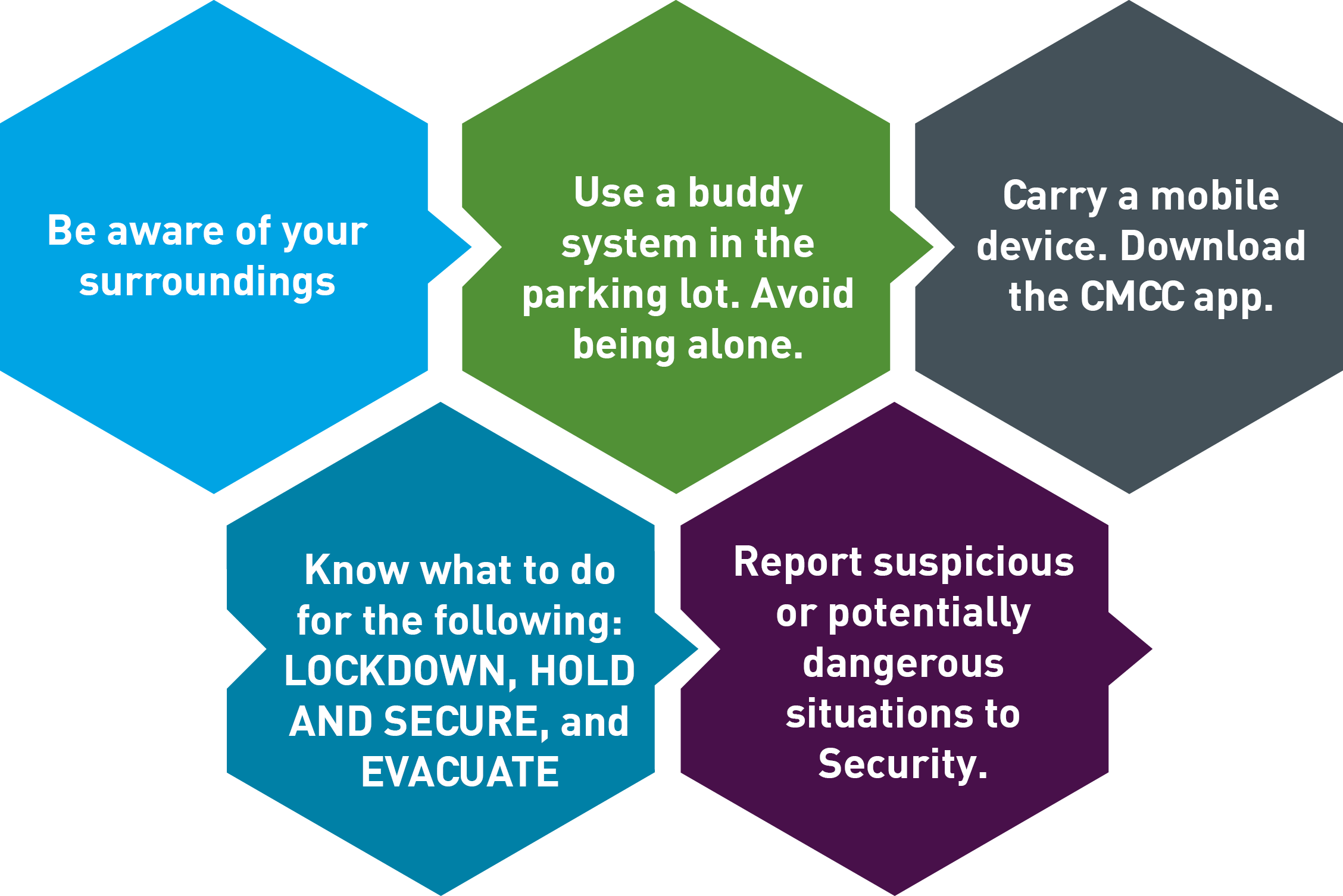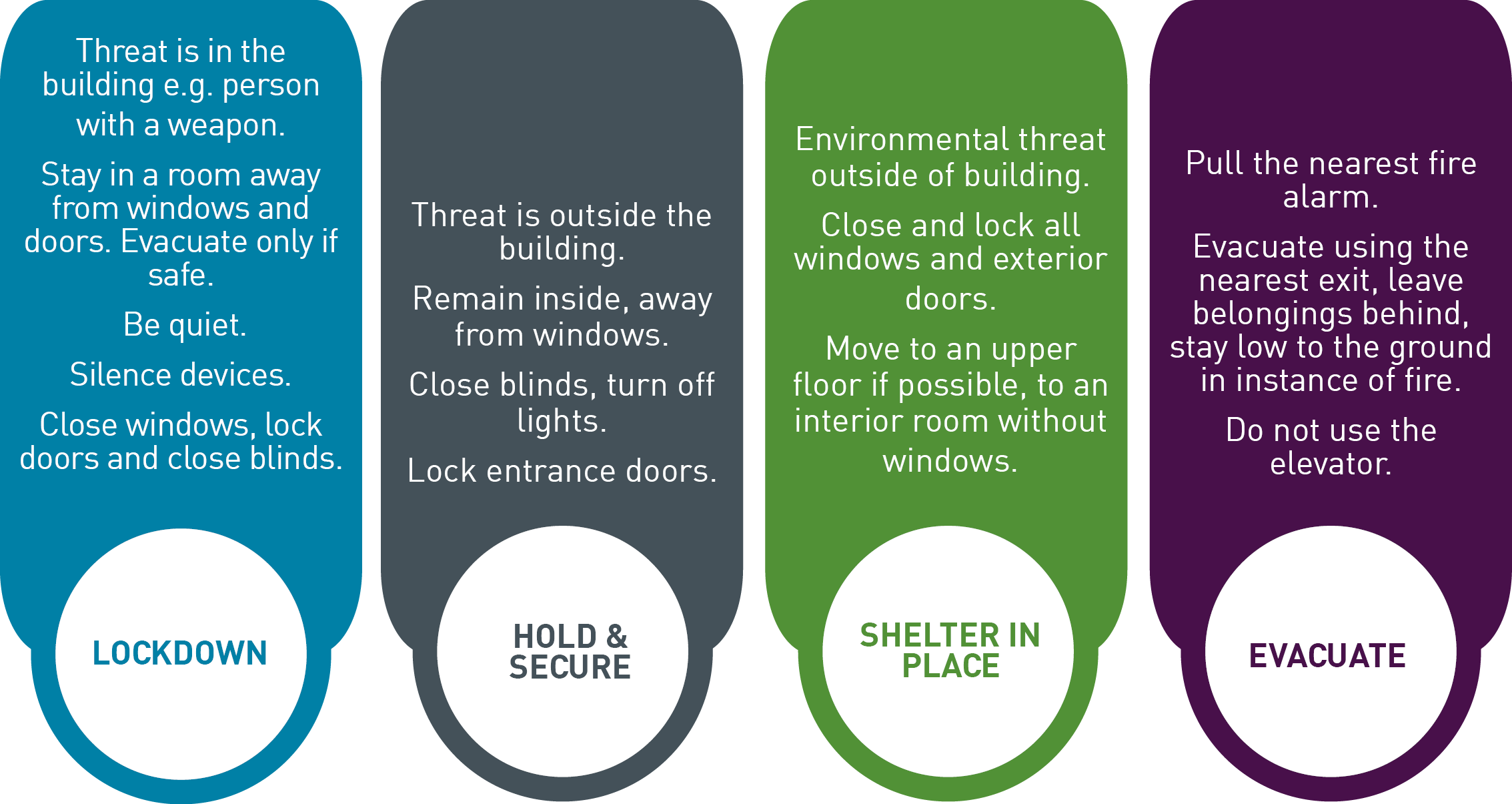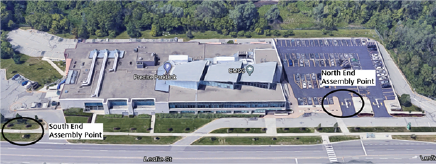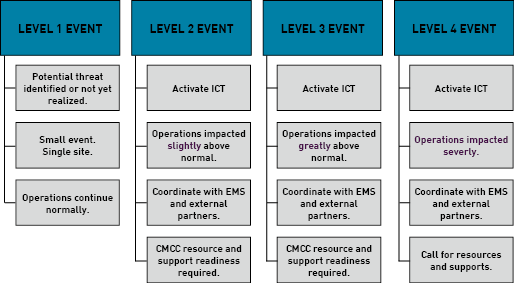The information on this webpage covers what you need to know in case of emergency or if you are in distress or seeking support. If you are in immediate danger, call 911.
Security Guard
Access controls are installed on all external entrances to the campus facility, other than the main entrance through which visitors must enter and sign in.
CMCC has a security guard onsite 24 hours, 7 days a week. If not on patrol, the guard will be at the main reception desk. If reaching the guard personally, is not an option, text, email or call for assistance or to report a concern.
- Text or call Security 416 - 910 – 3358 (cell)
- Email guard@cmcc.ca
- Enter "Security" to dial via Teams
Click to Access Emergency Guide as PDF
CMCC’S Campus Emergency Response Guide
The Campus Emergency Response Guide provides students and employees with instructions to effectively respond to situations that impact life and/or property at CMCC.
It does not include all possible scenarios and related response actions. Click on the tabs below for more information.

Security Guard
The security guard is onsite 24 hours, 7 days per week. They are stationed at the main reception desk and patrols the campus. To report a concern or receive assistance contact the guard in person, through text, email or Teams.
- Text or call Security 416 910 3358 (cell)
- guard@cmcc.ca
- Enter "Security" to dial via Teams
Alerts and Updates
In the event of an emergency that impacts community safety or operations, you will receive an emergency alert through one or more of the following: CMCC app, our speaker system, in-person, or email. You will also receive updates associated with the event through the same channels and if appropriate, CMCC’s webpage www.cmcc.ca.
Keep checking your device for updates. Always follow instructions from Emergency Services such as Police, Fire or Ambulance.
Common alerts that will require you to move into action immediately are:

FULL LOCKDOWN
- Active threat in the facility e.g. - person with a weapon:
- Leave the exterior doors unlocked for police.
- Enter the nearest room.
- Look quickly into the hallways and let non-threatening personnel into the room. Lock the door. Turn lights off.
- Close all windows and blinds.
- Consider barricading the door.
- Stay close to the floor unless told otherwise by someone in authority.
- Lie on the floor if gunshots are heard.
- Keep quiet.
- Keep mobile devices on but turn off sound.
- Keep away from windows.
- Call 911 with helpful information if it is safe to do so.
- Evacuate only if safe to do so.
- Relocate to another space if your security is compromised. Leave the building if you can.
- Head away from the building if you are outside.
- Call 911. Limit words if speaking out loud is not ideal. Dispatchers are trained to work with cues.
- Notify Security at Cell 416 910 3358.
- Remain in place until released.
- Monitor emergency notifications.
HOLD AND SECURE
Partial Lockdown due to a threat outside the facility or in the surrounding area.
- Return indoors.
- Close and lock exterior doors.
- Monitor exits/entrances for threats or to stop others from leaving while unsafe to do so.
- Close windows and window coverings.
- Turn off room lights.
- Stay away from windows.
- Silence devices, but keep them on.
- Call Emergency Services at 911.
- Notify Security at Cell 416 910 3358.
- Continue regular indoor routines if safe to do so. Outside activities are cancelled.
- Remain in place and monitor emergency notifications until Hold and Secure is lifted.
- Prepare to move into a full/complete lockdown if required.
SHELTER IN PLACE
When an environmental threat is present outside of the building and it is not possible or advisable to evacuate the facility, sheltering in place is required. This action is typically in response to an outside air contaminant and involves keeping the air contaminates outside the building and keeping persons from unnecessarily putting themselves in medical danger.
- Return indoors.
- Security guard, staff and students monitor exits/entrances.
- Shut off air exchange system.
- Close windows and window coverings.
- If necessary, move upwards to an interior room without windows, if possible, on a higher floor since many agents are heavier than air.
- Contact Security to provide updates.
- Using duct or other wide tape, seal all cracks around the door and any vents into the room.
- Building Operations staff should:
- Ensure exterior doors are locked.
- Turn off fans, heating, air conditioning and ventilation systems to avoid drawing in air from
the outside.
- Check the inventory of openings to ensure that no openings have been overlooked.
- Wait for next steps from Emergency Services.
- Monitor radio or television stations for further updates and have occupants remain in the shelter-in-place mode until authorities indicate it is safe to evacuate.
- Monitor emergency notifications.
FIRE AND/OR EVACUATION
- Pull the nearest fire alarm.
- Evacuate using the nearest exit, leave personal belongings behind. Stay low to the ground in instance of fire.
- Do not use the elevator.
- Call Emergency Services at 911.
- Notify Security at Cell 416 910 3358.
- Remain away from the building in assembly zones listed below until safe to return.
- Wait for next steps from Emergency Services.
- Monitor emergency notifications.
|
UPPER PARKING LOT ASSEMBLY ZONE NORTH
|
First Level: Use north doors to lower parking lot. Use outdoor stairs to street level
Second Level: Exit main entrance doors.
Third Level: Down the main stairs. Exit through main entrance.
|
LESLIE ST/CUMMER ST SOUTH OF PROPERTY ASSEMBLY ZONE SOUTH
|
First Level: Exit south doors and proceed up steel staircase.
Second Level: Exit CCPA Hall street facing doors (east).
Third Level: Use south stairs down to first level, exit through south doors and up (steel) stairs.
|

AGGRESSIVE BEHAVIOUR
If you feel threatened in any of these scenarios call 911 and contact Security 416 910 3358
| Stage 1 Early Warning Signs
Fidgeting, tapping on table, pacing, crossed arms, rude language, intoxication.
- listen
- maintain a safe distance
- stay calm
- seek to understand the problem
- don’t be dismissive
- ask for a solution
|
Stage 2 Early Warning Signs
Raised voice, rapid breathing, red face, scoffing, rude/offensive language, name calling, argumentative tone of voice.
- maintain a safe distance
- alert another co-worker or manager,
- stay calm
- have a means of egress (a safe room or area)
- allow for silence
- be patient
- try to move individuals to a safe location away from others, if possible
|
| Stage 3 Threatening Behavior
Clenched fist, red face, clenched jaw, yelling, waving objects, finger pointing, threats of violence.
- distance yourself (at least 2 m)
- remain calm
- do not physically engage
- continue to communicate
|
Stage 4 Assaultive
Pushing, shoving, striking, etc.
- if physical aggression is imminent, be prepared to defend yourself. Prior training on physical intervention techniques is recommended for staff who are responding to high-risk situations.
|
BOMB THREAT OR SUSPICIOUS PACKAGE
Phone or Verbal Threat:
- Document as much detail as you can on the caller.
- Record the call if possible.
- While on the phone with the caller, have someone else call 911.
- Have that person also contact Security at Cell 416 910 3358.
- Wait for next steps from Emergency Services.
- Monitor emergency notifications.
Social Media Threat:
- Leave message open on computer, take a screen shot/photo/print the page.
- Call Emergency Services at 911.
- Notify Security at Cell 416 910 3358.
- Wait for next steps from Emergency Services.
- Monitor emergency notifications.
Suspicious Package Found:
- If you discover a suspicious item, do not touch, and notify Security at Cell 416-910-3358 immediately. They will contact police for direction.
- Security will initiate a visual scan and/or determine if relocation or evacuation is necessary.
- If a suspicious package is found, do not use any electronic device, cell phone or walkie talkie in close proximity.
- If ordered to evacuate, remain at the evacuation site until Security and/or the Police provide further instruction.
- If instructed to evacuate be aware of your evacuation route and continually scan your surroundings until safely at the evacuation site.
- If an explosive incident occurs, follow established school evacuation procedures. Contact police.
Once evacuated from the building:
- Avoid standing in front of windows or other potentially hazardous areas.
- Do not block the sidewalk or street. It will need to be kept clear for emergency officials.
In the case of an explosion:
- Get out of the building as quickly and calmly as possible.
- If items are falling off bookshelves or from the ceiling, get under a sturdy table or desk until the situation has stabilized enough for your safe passage.
- Ensure your own safety before trying to help others.
Making a bomb threat is a criminal offence. Do not try to guess whether the threat is real or a hoax. Call the police.
CHEMICAL RELEASE
Hazardous chemicals could be purposefully released or accidentally released. Accidents could be due to manufacturing, storage or transportation, such as during a train derailment. Here are some things to consider when there is a chemical release that impacts your environment:
Listen for official advice
- Emergency responders are trained to identify hazards and provide appropriate guidance to the public. In some situations, you should seal yourself inside the building you are in (See Shelter in Place under Lockdown). Other times, you may be instructed to go to higher elevations or evacuate the area.
- Monitor emergency notifications.
In an enclosed area
- If you suspect that a chemical substance has been released in a closed area such as a subway or building, try to avoid breathing any of the fumes and evacuate as quickly as possible.
- If possible, refer to the Material Data Safety Sheet to understand exposure management.
- Immediately contact the closest police, fire and ambulance services.
- Decontamination might be required before you can receive medical attention.
- Follow advice from local officials.
- Monitor emergency notifications
In the case of an explosion:
- Get out of the building as quickly and calmly as possible.
- If items are falling off bookshelves or from the ceiling, get under a sturdy table or desk until the situation has stabilized enough for your safe passage.
- Ensure your own safety before trying to help others.
Medical treatment
- Exposure to a chemical substance may require quarantine and the attention of medical authorities. Because the type of chemical may not be known right away, treatment is based on symptoms.
- Keep track of things like breathing and heart rate, perspiration, dizziness, skin tone, deliriousness.
- Tell medical personnel and public health agencies about these or any other symptoms.
CIVIL DISTURBANCE
A demonstration should not be of concern unless one or more of the following conditions exists:
- Threat of physical harm to persons or damage to CMCC facilities or property.
- Interference with the normal operations of the CMCC
- Blocking off access to offices or other CMCC facilities, causing possible dangerous situations
- Call Emergency Services at 911.
- Notify Security at Cell 416-910-3358
- Wait for next steps from Emergency Services.
- Monitor emergency notifications.
- Do not respond to media questions, refer the media to communications.
- Upon exiting your work area, secure confidential information.
- Take mobile devices with you if possible.
COMMUNICABLE DISEASE
For diseases that can transmit to others and are considered life threatening:
- Affected individual and close contacts must isolate immediately and wear personal protective equipment.
- Refer to the infection prevention and control guide where isolation procedures are outlined.
- Contact public health. Contact HR, Student Services or Clinic.
- Conduct a risk assessment with public health.
- Determine contacts of the individual affected and notify them.
- Disinfect areas and initiate health screening if necessary.
- Monitor emergency notifications.
CYBERATTACK
Contact CMCC helpdesk@cmcc.ca if the following occurs:
- Your files are not accessible due to a message you received from a hacker.
- Privacy has been breached and/or you have been asked to pay ransom for return of your data.
- Helpdesk will make an assessment, directly assist affected individual or escalate to the Chief
Information Officer (CIO) depending on severity of issue.
- CIO will work with leadership to determine next steps.
FLOOD
- Notify Facilities and/or Emergency Manager to determine if evacuation is required.
- Move to a higher floor if necessary. Avoid areas with flooding and do not walk through them.
- Facilities department to notify utility companies.
- Limit access to the building.
- Monitor emergency notifications. Monitor news channels to find out what areas are affected,
what roads are safe, where to go and what to do if the local emergency team requires you to
evacuate.
If you need to evacuate
- Follow the routes specified by officials. Don’t take shortcuts. They could lead you to a blocked or
dangerous area.
Never cross a flooded area
- If you are on foot, fast water could sweep you away.
- If you are in a car, do not drive through flood waters or underpasses. The water may be deeper
than it looks, and your car could get stuck or swept away by fast water.
- Avoid crossing bridges if the water is high and flowing quickly.
- If you are caught in fast-rising waters and your car stalls, leave it, and save yourself and your
passengers.
Refer to Get Prepared for more information.
https://www.getprepared.gc.ca/cnt/rsrcs/pblctns/flds-wtd/index-en.aspx#s3
MEDICAL EMERGENCY
- If you are qualified to administer Standard First Aid and CPR, assist the affected individual. If
not, find a qualified Standard First Aid responder – chiropractors and students are certified in
standard first aid and CPR.
- Call 911.
- Notify Security at Cell 416-910-3358
- Post someone at the entrance door to guide emergency responders to the location.
- Wait for next steps from Emergency Services.
- Monitor emergency notifications.
- Document information on incident, including person’s name.
- Contact HR, Student Services or Clinic who must notify the emergency contact. on file for
student, employee or patient.
POWER OUTAGE - ELECTRICITY, NATURAL GAS AND WATER
- Move to a lit location (window) if the electricity is out.
- If in Clinic, remain with your patients however patient care must stop immediately.
- Facilities will find the source of the power outage, and report to Toronto Hydro.
- Facilities will activate the power generator, in order to keep medical equipment and other
operational needs running (generator is activated by a transfer switch to run on emergency
power).
- Wait for instructions on whether to stay or leave the building.
- Monitor media for notifications.
- Monitor emergency notifications.
- Campus Security is to ensure everyone leaves the building.
ROBBERY
- Remain calm.
- Obey the robber’s commands. If possible, call 911 immediately.
- Do not antagonize the robber.
- Consider any firearms to be fully loaded.
- Look at the robbers - notice details to aid you in describing them and their mannerisms. Note
gender, ethnicity, eye colour, age, weight, height, clothing, tattoos or scars.
- Take note of the weapon.
- Watch the direction the robbers take - if they use a vehicle, try to note the license plate number.
After the Robbery
- Call 911.
- Notify Security at Cell 416-910-3358.
- Give your name, telephone number and the address of the hold-up.
- Give a description of the suspect(s), direction of travel, and a license number if a vehicle was
used.
- Advise whether or not weapons were used.
- Protect the crime scene. Keep customers or other employees away from the area of the store
where the robbery occurred.
- Ask witnesses to wait until the police arrive.
- Lock the door until the police arrive.
- Do not touch anything.
- Save any notes that were used - do not handle it or let others handle it.
- Co-operate with the police.
SUICIDE THREAT OR PERSON IN CRISIS
- If you are certified in Mental Health First Aid, aid the affected individual.
- Call 911. If necessary, use codewords for 911 “I have a PIC” (person in crisis).
- Notify Security at Cell 416-910-3358.
- If safe to do so, remain with the individual who is actively threatening suicide until Emergency Services arrive.
- Campus Security and Facilities must limit access to the building.
SEVERE STORMS
- If you are indoors, stay away from windows, exterior doors.
- Evacuate if advised to do so.
- You can use a cellular telephone during a severe storm, but it’s not safe to use a land-line
telephone.
- If you are in a car, stop the car away from trees or power lines that might fall on you. Stay there.
- Monitor weather advisories.
- Executive team will make the determination to close campus early, stay indoors, and/or close
campus for defined period depending on weather circumstances.
- Monitor emergency notifications.
Lightning
- Always take shelter during a lightning storm.
- There is no safe place outside during a thunderstorm. Safe shelter can be found either in an
enclosed building or a hard-topped vehicle.
- If you can see lightning or hear thunder, you are in danger of being hit. Seek shelter immediately.
- Wait 30 minutes after the last lightning strike in a severe storm before venturing outside again.
- Do not ride bicycles, motorcycles, tractors, or golf carts. These will not protect you from a
lightning strike.
Thunderstorms
- During thunderstorms, you should also stay away from items that conduct electricity, such as
corded telephones, appliances, sinks, bathtubs, radiators and metal pipes.
Hail
- Take cover when hail begins to fall, especially if accompanied by high winds.
- When a hailstorm hits, stay indoors, and keep away from windows, glass doors and skylights
which can shatter if hit by hailstones. Avoid using a landline, and do not touch metal objects like
stoves, radiators, metal pipes, and sinks.
- When a hailstorm hits, find shelter and avoid underpasses or any low-lying areas that may flood.
Ice Storms
- Ice from freezing rain accumulates on branches, power lines and buildings. If you must go, pay
attention to branches or wires that could break due to the weight of the ice and fall on you. Ice
sheets could do the same.
- Never touch power lines. A hanging power line could be charged (live) and you could be
electrocuted. Remember that ice, branches or power lines can continue to break and fall for
several hours after precipitation ends.
- When freezing rain is forecast, avoid driving. Even a small amount of freezing rain can make
roads extremely slippery. Wait several hours after freezing rain ends so that road maintenance
crews have enough time to spread sand or salt on icy roads.
Visit Get Prepared for additional information on what to do to protect yourself during severe weather and preparing for it.
TORNADO
- Take shelter in an inner hallway or room, ideally in the basement or on the ground floor.
- Do not use the elevator.
- Stay away from windows.
- Large buildings with wide-span roofs such as , gymnasium, church or auditorium may collapse if a tornado hits. If possible, find shelter in another building or take cover under a sturdy structure such as a table or desk.
- Get as close to the ground as possible, protect your head and watch for flying debris.
- Do not chase tornadoes - they are unpredictable and can change course abruptly.
- A tornado is deceptive. It may appear to be standing still but is, in fact, moving toward you.
- Stay alert, monitor emergency notifications and comply with emergency instructions.
Any media questions must be referred to the Division of Marketing and Communications communications@cmcc.ca. Correspondence must be approved by the President’s Office.
A temporary Incident Command Team (ICT) if required will be set up in order to respond to a major emergency that impacts community safety or operations. This group is activated by the Emergency Manager through the security guard.

ICT will conduct a risk assessment of the event and implement measures for the safety and continuity of operations in consultation with executive leadership and emergency services. If an ICT is not required, the Emergency Manager will work with the appropriate personnel to facilitate response and recovery operational procedures as required.
In all instances the division of Physical Facilities will be contacted as well.
Refer to the chart below for ICT activation criteria.
Emergency Managers:
Allan Eveyln
Vice President of Finance and Administration
P. 647-265-4242 E. aevelyn@cmcc.ca
Physical Facilities:
Tony Maiato
Director of Physical Facilities
P. 647-805-1737 E. tmaiato@cmcc.ca
Rob Hackett
Superintendent
P. 647 – 805-1739 E. rhackett@cmcc.ca
Jean Fung
Office, Coordinator
P. 647-805-1738 E. jfung@cmcc.ca

CMCC Support
Students can book an appointment with our Student Success Counsellor, Karen Rice, E. krice@cmcc.ca, P. 647- 417-8061 or Registrar, Patti Scott, E. pscott@cmcc.ca P. 647-417-8254.
You are welcome to visit the Student Services office in room 220 Monday to Friday 8:00 am-5:00 pm. All discussions are confidential.
Note: Students who are enrolled in the Student Health and Dental Plan offered by CMCC Students' Council have access to Empower Me. Empower me is a confidential mental health and wellness service that is available 24/7, 365 days a year. Empower Me can help students with various areas, including mental health, family and relationships, stress and anxiety and more. Visit www.studentcare.ca/dialogue.
Employees can book an appointment with the Director of Human Resources, Sharlene Browne E. sbrowne@cmcc.ca P. 416-428-2340 ext. 254.
You are also welcome to visit the Human Resources office in room 330 on the third floor Monday to Friday from 8:00 am – 5:00 pm. All discussions are confidential.
You may prefer to contact the Confidential Employee Assistance Programs (EAP) through our third-party vendor InkBlot. Contact EAP online by visiting www.inkblottherapy.com/gsc-eap services
Patient Concerns
Speak with your intern or clinician if you have a concern or require support. Concerns regarding your clinic experience can be sent to David Aronson, Director, Clinic Operations and Initiatives E. daronson@cmcc.ca P. 647-417-8060.
Indigenous Counselling Services
Anishnawbe Health Toronto (AHT)’s Traditional Team uses both traditional and western approaches to healing. They provide non-judgmental, compassionate support and work with individuals on a broad range of issues, such as: abuse (physical/emotional/sexual/spiritual), effects of the residential school system, heritage identity, substance use, adoption and foster care issues, self-esteem, and relationship issues. Through AHT’s culture and traditional healing methods, Traditional Healers, Elders and Medicine People help individuals, families and communities strive for balance, harmony, and good health.
Other Public Services




